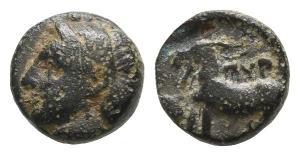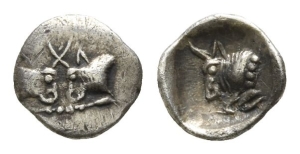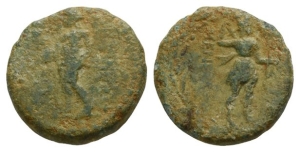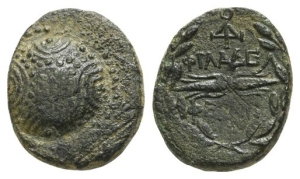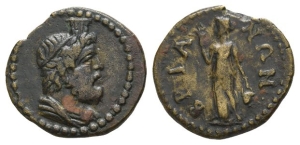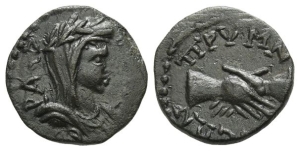Home > Auctions > 26 November - 1 December 2024
Ancient Art, Antiquities, Natural History & Coins
Very Fine. Very rare mint.
From the collection of a London antiquarian, formed since the 1980s.
Pyrrha was a town on the coast of the deep bay on the west of the island of Lesbos, which had such a narrow entrance that it was called the Euripus of Pyrrha. In the Lesbian revolt the town sided with Mytilene, but was reconquered by Paches. By the time of the geographer Strabo the city no longer existed, but the suburbs and the harbour were still inhabited and Pliny reports that Pyrrha had been submerged by the sea (5.39).
Very Fine. Apparently unpublished and possibly unique.
From the collection of a London antiquarian, formed since the 1980s.
The fact that the present coin has the same reverse stellate pattern as the Diobols of Miletos (cf. SNG Kayhan I 462-75 and SNG Copenhagen 953) and some of the silver coins of the satraps of Caria (cf. HN Online 2926), leads us to attribute its origin to one of these two regions.
Extremely Fine. Unusually well struck for the type.
From the collection of a London antiquarian, formed since the 1980s.
Near Very Fine. Very rare.
Ex 'V' gentleman's collection, Switzerland. From the property of a North London, UK, gentleman.
Good Very Fine.
Ex 'V' gentleman's collection, Switzerland. From the property of a North London, UK, gentleman.
Very Fine.
Ex 'V' gentleman's collection, Switzerland. From the property of a North London, UK, gentleman.
Near Very Fine. Edge chipped.
From the collection of a London antiquarian, formed since the 1980s. Ex Classical Numismatic Group, Electronic Auction 545, 30 August 2023, lot 411.
Good Very Fine. Rare.
From the collection of a London antiquarian, formed since the 1980s.
Good Very Fine.
From the collection of a London antiquarian, formed since the 1980s.
Near Very Fine.
Property of a North London, UK, gentleman.
Very Fine. Very rare.
From the collection of a London antiquarian, formed since the 1980s.
Good Very Fine. Unpublished and unique; of great historical and numismatic importance.
Ex 'V' gentleman's collection, Switzerland. From the property of a North London, UK, gentleman.
It is not rare when a coin can be the only evidence about the existence of a person or city from the past. On this particular coin, it is the inscription of YΠΑΙΟΡΟ that makes it difficult to attribute. No city or ruler is recorded with this name and the only ancillary evidence we have is its similarity to some other types. First of all, the style of the leather helmet (called bashlyk, common for the Cappadocian bronzes) and the lack of the royal title, refer us to the king of Cappadocia, Ariaramnes. The Roma's example is the only other example who bears the abbreviated legend YΠΑΙ but on a coin of Ariarathes. On the other hand, the reverse type and style of legend resemble the bronze coins of Antiochos III struck in Southern Coele-Syria (SC 1100a; HGC 9, 493b). It is not certain whether the name refers to a city or to a ruler. Bronze coins of Ariaramnes can have the name of the mint abbreviated (cf. Simonetta 9a&b), but it is considered unusual in this period to have a bronze coin with a full ethnic and the portrait of the ruler. It is very likely that we are dealing with the name of a Cappadocian ruler who was active for a short period in the second half of the 3rd to the first part of the 2nd century and participated in the recovery of the outlying provinces of the Seleucid Empire from Antiochos III.
2197 - 2208 of 3419 LOTS

